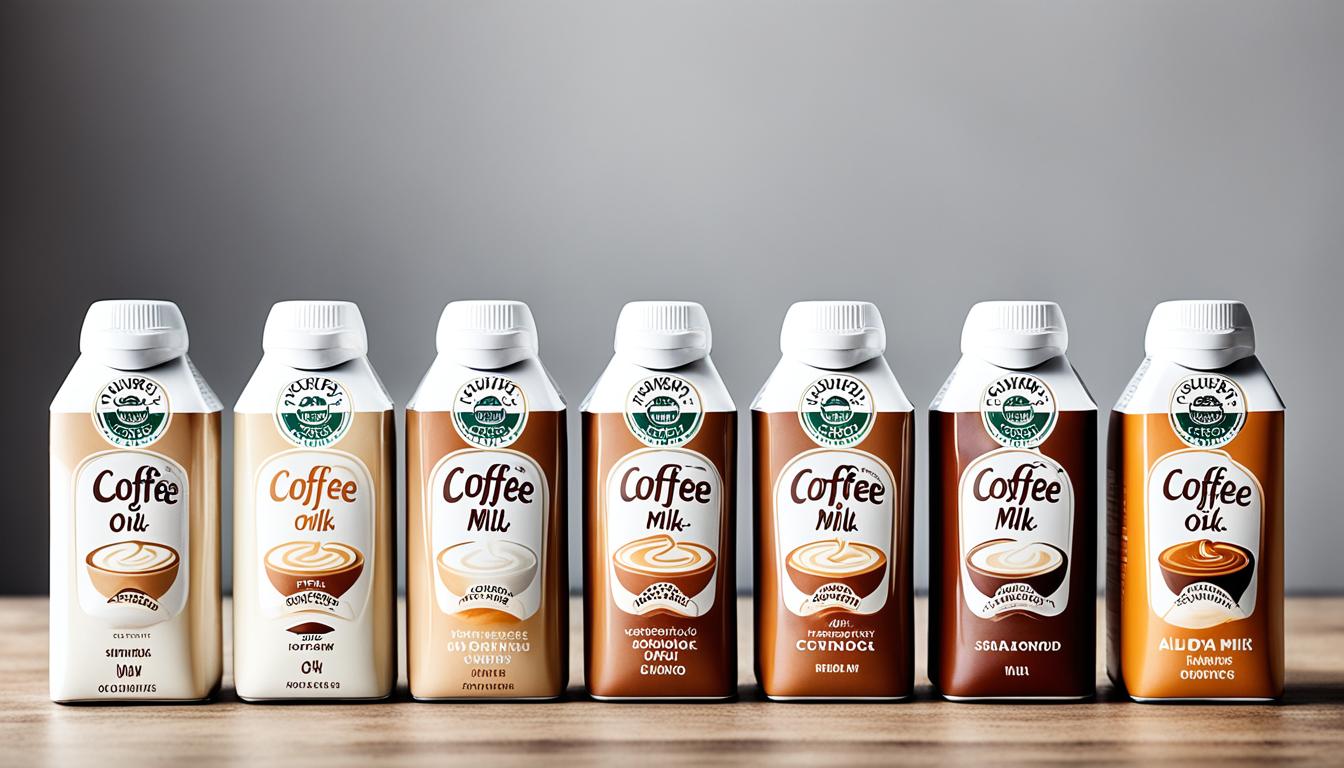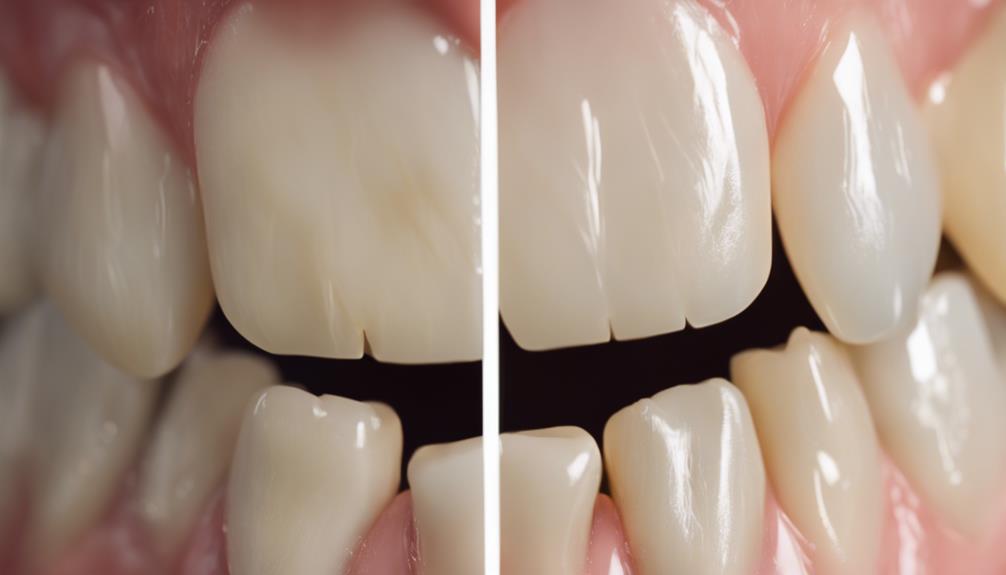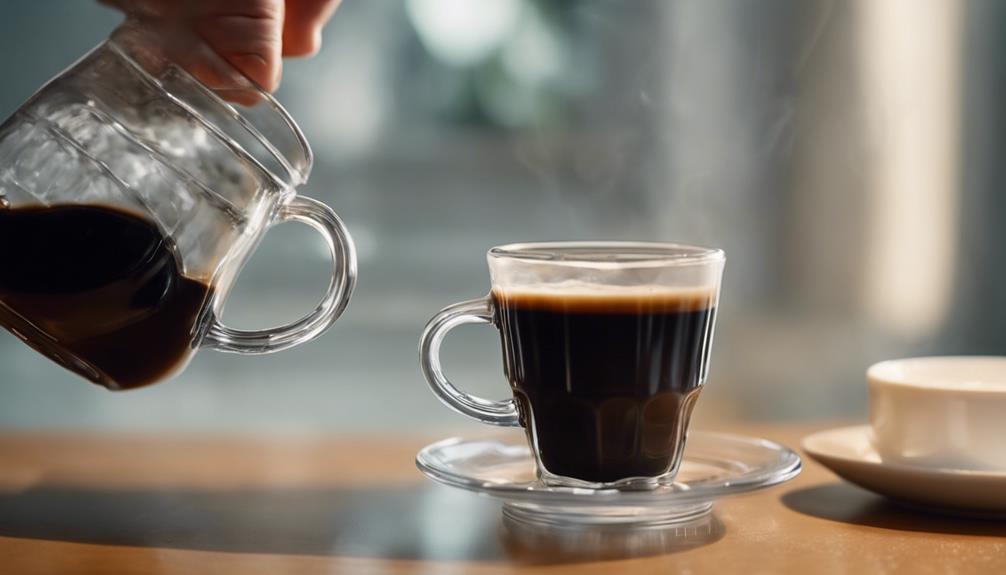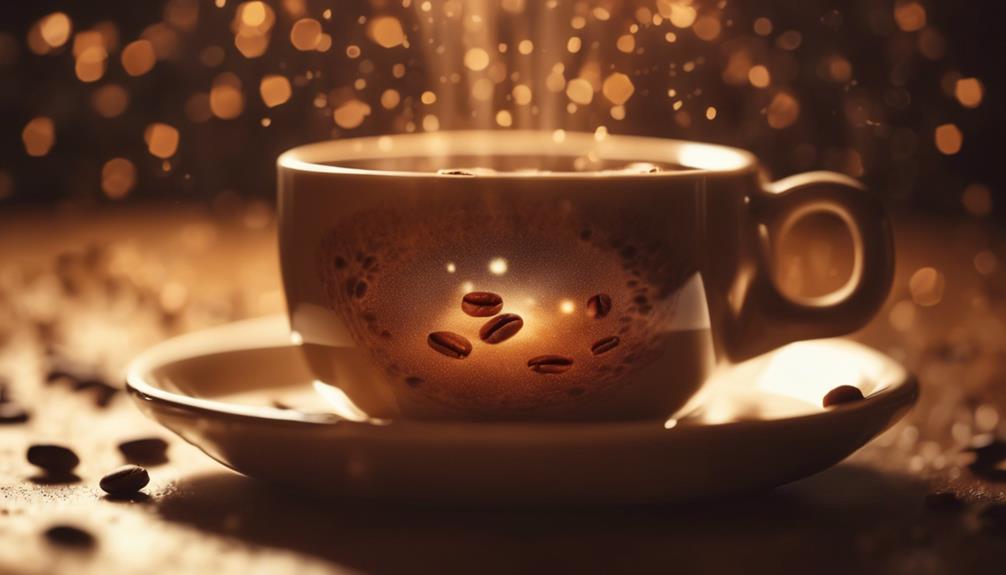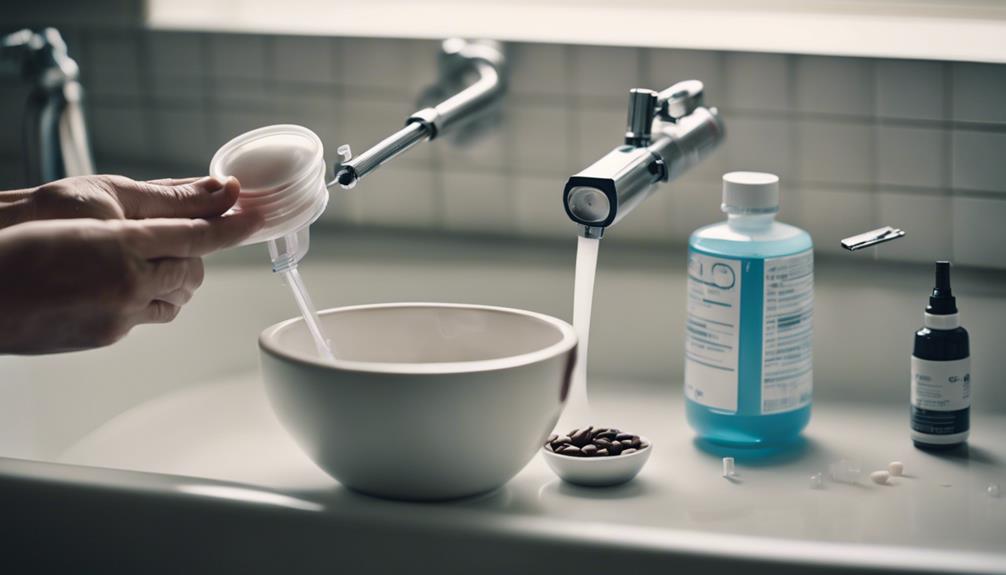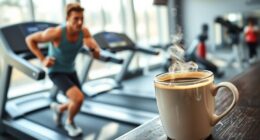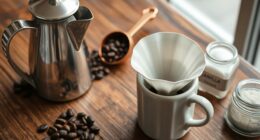When you’re wearing Invisalign, it is advisable to drink coffee with a straw in order to reduce the risk of staining and damaging your aligners. Using a straw helps to minimize direct contact between the coffee and your aligners, which can prevent warping and discoloration. Metal or glass straws are eco-friendly alternatives to plastic ones. By following this guideline, you can enjoy your coffee without compromising your aligners. To fully understand the best practices for drinking coffee with Invisalign, it is important to consider factors such as temperature, oral hygiene, and aligner care. Exploring these elements will offer a comprehensive approach to safeguarding your orthodontic treatment.
Key Takeaways
• Drinking coffee with a straw while wearing Invisalign helps minimize staining and damage to aligners.
• Metal or glass straws are environmentally friendly options for protecting aligners from coffee stains.
• Using a straw reduces direct contact between coffee and aligners, reducing the risk of staining and damage.
• It's essential to monitor coffee temperature and use a straw to prevent warping or deforming aligners.
• After drinking coffee, rinse aligners with lukewarm water and brush them gently to maintain cleanliness and transparency.
Coffee and Invisalign: Safe Combo?
When you're wearing Invisalign and craving a cup of coffee, you might wonder if it's safe to enjoy your daily brew while straightening your teeth.
The good news is that drinking coffee with Invisalign isn't entirely off-limits. However, it's essential to take precautions to prevent staining and potential damage to your aligners.
Coffee can leave behind stubborn stains on your Invisalign aligners, which can be challenging to remove. Moreover, the high temperature of hot coffee can cause your aligners to warp or become misshapen.
To minimize the risks, consider using a straw when drinking coffee. This simple trick can help reduce the contact between the coffee and your aligners, thereby reducing the likelihood of staining and damage.
Straw Benefits for Aligner Protection
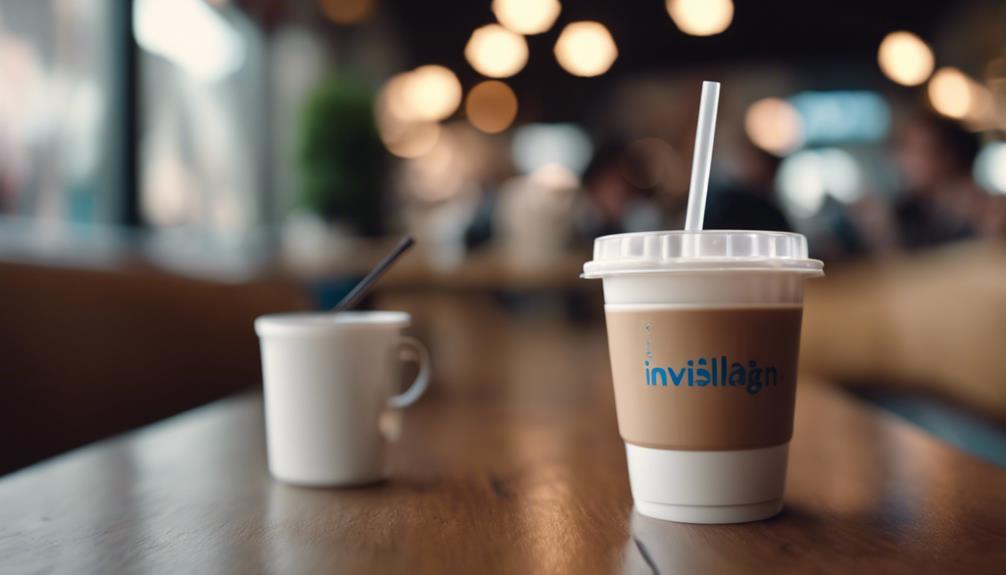
By incorporating a straw into your coffee-drinking routine, you can significantly reduce the risk of staining and damage to your Invisalign aligners. This is because straws direct the coffee past your teeth and aligners, minimizing contact between the two. As a result, you'll decrease the chances of discoloration or damage to your aligners.
By choosing reusable metal or glass straws, you can protect your aligners while being environmentally friendly. Using a straw is a simple and effective method to keep your aligners clear of coffee stains and maintain their transparency.
Drinking coffee with a straw can be a practical way to enjoy your favorite beverage without compromising your Invisalign treatment. By reducing the contact between coffee and aligners, you'll minimize the risk of staining and damage. With a straw, you can enjoy your coffee without worrying about the negative effects on your Invisalign aligners. Additionally, using a straw can also help prevent the coffee from seeping under the aligners, which can cause bacterial growth and potential cavities. It’s important to maintain good oral hygiene during Invisalign treatment, and using a straw for your coffee can be a simple way to help achieve that. So, next time you want to enjoy a cup of coffee, consider using a straw and continue to drink coffee with retainer for a hassle-free experience.
Coffee Temperature Matters

You'll want to be mindful of the temperature of your coffee, as hot coffee can potentially warp your Invisalign aligners. Drinking hot coffee can be risky, but using a straw can help minimize the risk of temperature sensitivity. This is especially important because Invisalign aligners are designed to be worn for extended periods, and exposure to hot liquids can cause them to lose their shape.
Here are some key considerations to keep in mind:
- Hot coffee can warp aligners: Direct contact with hot coffee can cause your aligners to deform, which can affect their fit and effectiveness.
- Straws reduce risk: Using a straw can help reduce the risk of temperature sensitivity by minimizing direct contact between the hot coffee and your aligners.
- Temperature sensitivity matters: Be mindful of the temperature of your coffee to avoid damaging your aligners and compromising your orthodontic treatment.
- Safe coffee consumption is possible: By using a straw and being mindful of the temperature of your coffee, you can enjoy your favorite beverage while protecting your Invisalign aligners.
Brushing After Coffee Consumption
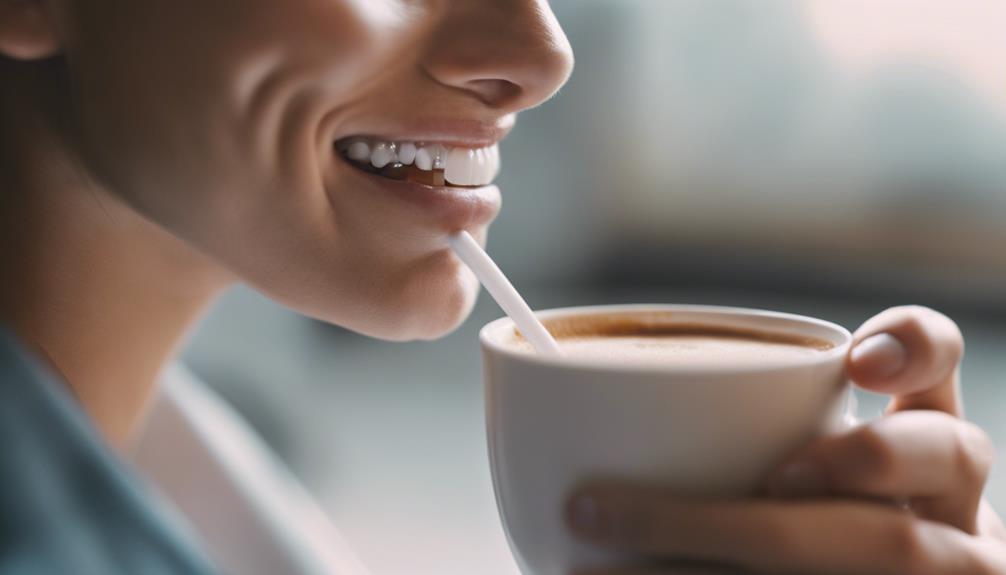
Taking care of your teeth and aligners requires prioritizing proper care to maintain good oral hygiene and prevent any potential issues. Brushing your teeth with a soft toothbrush after drinking coffee helps to effectively clean your teeth and aligners, removing any residue that could lead to staining.
Regular brushing also prevents plaque buildup and maintains the transparency of your aligners. By making brushing a habit after coffee consumption, you can minimize the risk of discoloration and ensure the effectiveness of your Invisalign treatment.
Remember to brush and floss regularly to remove any residue and maintain good oral hygiene. By taking these simple steps, you can enjoy your coffee while wearing Invisalign, knowing that you're taking care of your teeth and aligners.
Invisalign Care After Coffee

After enjoying your coffee, it's time to focus on Invisalign care to prevent any residue from affecting your aligners.
To maintain the cleanliness and effectiveness of your Invisalign, you'll need to take a few simple steps.
- Rinse your Invisalign aligners with lukewarm water to remove any coffee particles.
- Gently brush your aligners with a soft-bristled toothbrush to keep them clean and transparent.
- Make sure to dry your aligners thoroughly before putting them back in to prevent bacteria growth.
- Following a coffee break, maintain your aligner care routine by brushing and flossing before reinserting them.
Coffee Options for Aligner Safety

When it comes to enjoying coffee while wearing Invisalign, you'll want to take into account the type of coffee you're drinking to guarantee aligner safety.
You can start by exploring safe brewing methods that minimize acidity and staining risks. By choosing low-acid coffee options and controlling the temperature, you can enjoy your coffee without compromising your aligners' clarity and effectiveness.
Safe Brewing Methods
By opting for cold brew or iced coffee, you'll find that the lower acidity and smoother taste make them safer options for enjoying coffee with Invisalign. These drinks like coffee are perfect for those who want to indulge in their favorite beverage while protecting their aligners.
Here are some benefits to consider when choosing a brewing method:
- Less acidic: Cold brew and iced coffee have lower acidity levels, reducing the risk of eroding your teeth or damaging your aligners.
- Smoother taste: The smoother taste of cold brew and iced coffee makes them more enjoyable to drink, and the lower acidity reduces the risk of discomfort while wearing Invisalign.
- Using a straw is a plus: When drinking iced coffee, using a straw can help direct the liquid past your teeth and aligners, minimizing contact and reducing the risk of staining.
- Environmentally friendly: Opt for metal or glass straws, which are environmentally friendly alternatives to traditional plastic straws.
Low-Acid Coffee Options
Take control of your coffee habit with low-acid options that prioritize your aligner safety, and you'll be sipping your way to a healthier, happier smile.
As an Invisalign wearer, you're likely aware of the importance of protecting your aligners from stains and discoloration. One effective way to do so is by opting for low-acid coffee options. These varieties reduce the risk of enamel erosion and tooth sensitivity, making them a safer choice for your oral health.
Cold brew coffee, for instance, is less acidic and smoother in taste, making it an excellent option for aligner wearers. Lighter roast coffee varieties are also gentler on teeth and aligners, promoting oral health.
Temperature Control Matters
You can further safeguard your Invisalign aligners by controlling the temperature of your coffee, as excessive heat can cause warping or discoloration. When drinking hot coffee through a straw, the temperature can be a concern. However, you can take steps to minimize the risk.
Here are some tips for temperature control:
- Opt for lukewarm coffee: Instead of scalding hot coffee, try drinking it when it's lukewarm. This reduces the risk of warping or discoloration.
- Use a straw: Directing the coffee flow through a straw can help minimize contact between the hot liquid and your aligners.
- Choose iced or cold brew: If you're concerned about temperature, consider switching to iced or cold brew coffee. This eliminates the risk of hot coffee damaging your aligners.
- Select the right straw material: Opt for metal or glass straws, which are more durable and less likely to warp or discolor your aligners.
Stain Prevention and Removal Tips

One simple trick to prevent coffee stains on your Invisalign aligners is to drink through a straw, which diverts the coffee away from your teeth and aligners, reducing the risk of discoloration. Opt for reusable or biodegradable straws to minimize environmental impact.
By using a straw, you're taking a significant step towards stain prevention. Additionally, swishing water after taking a sip of coffee can help remove coffee particles and prevent staining.
Regularly rinsing your aligners with cold water is also vital in maintaining their transparency and preventing discoloration. This habit will help you keep your aligners clean and stain-free.
Frequently Asked Questions
Do Straws Help With Invisalign?
When you're wondering if straws help with Invisalign, the answer is yes. Straws can be a game-changer when it comes to enjoying coffee while wearing aligners.
What Is It OK to Drink While Wearing Invisalign?
As you wear Invisalign, you're likely wondering what beverages are safe to drink. To maintain aligner transparency and oral hygiene, it's recommended to drink clear, non-sugary, and non-acidic beverages like water.
Avoid drinking coffee, tea, or colored drinks, as they can stain your aligners. Stick to water or other clear liquids to guarantee your Invisalign treatment remains effective and your aligners stay clean.
Can I Drink Coke Through a Straw With Invisalign?
Are you wondering if you can enjoy Coke with your Invisalign? The answer is yes, you can!
Drinking Coke through a straw is a great way to minimize direct contact between the beverage and your aligners, reducing the risk of staining. Opt for a reusable or biodegradable straw to be environmentally friendly.
What Is the Coffee Alternative for Invisalign?
You're looking for a coffee alternative that won't compromise your Invisalign treatment. Consider switching to lighter-roast coffees or try matcha tea or herbal tea with almond milk for a caffeinated alternative.
Iced coffees and iced chai are also great options that are less likely to stain your aligners. Choose beverages that won't leave residue on your teeth or aligners, ensuring the effectiveness of your Invisalign treatment.
Conclusion
As you sip your coffee through a straw, remember that moderation is key. Don't let your love for coffee stain your Invisalign journey.
With careful planning, you can enjoy your daily cup while keeping your aligners safe.
By following these guidelines, you'll be on track to a successful orthodontic treatment, with a healthy, beautiful smile shining bright at the finish line.
Your discipline will pay off, and that perfect smile will be the perfect blend.

